Financial Analysis: Sources & Distribution of Funds in Tourism
VerifiedAdded on 2024/04/24
|40
|6021
|127
Report
AI Summary
This report provides an analysis of finance and funding within the travel and tourism sector, emphasizing the importance of cost, volume, and profit (CVP) analysis for management decision-making. It explores various pricing methods used in the industry, factors influencing profitability, and different types of management accounting information (MAI) with a case study of Dalata Hotel Group plc. The report interprets the financial accounts of Dalata Hotel Group plc for the year ended 2016, assessing their performance over two years, and analyzes sources and distribution of funding for capital projects associated with tourism development. The document highlights the significance of cost behavior, volume analysis, and pricing strategies in maintaining competitiveness and achieving financial sustainability in the travel and tourism industry.
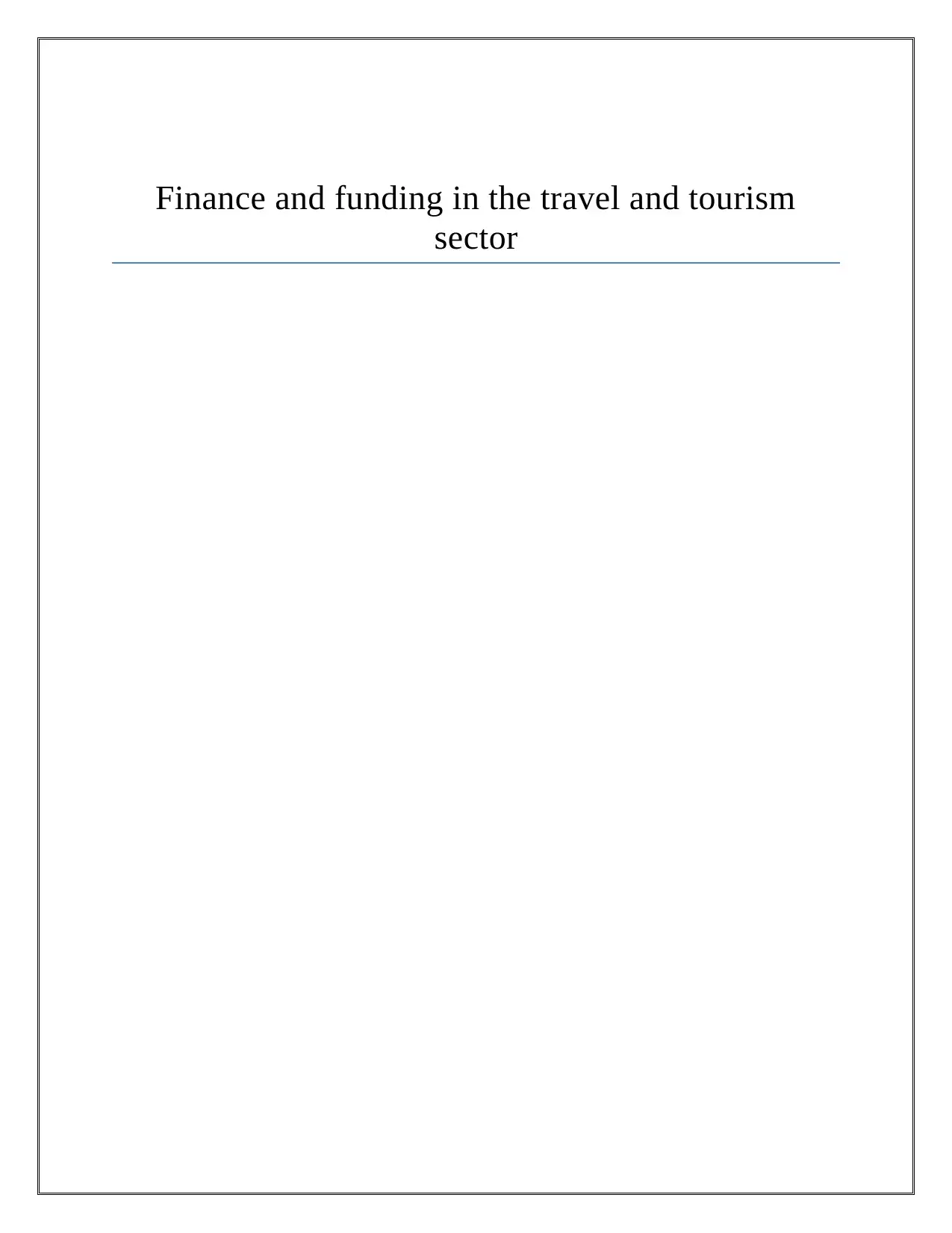
Finance and funding in the travel and tourism
sector
sector
Paraphrase This Document
Need a fresh take? Get an instant paraphrase of this document with our AI Paraphraser
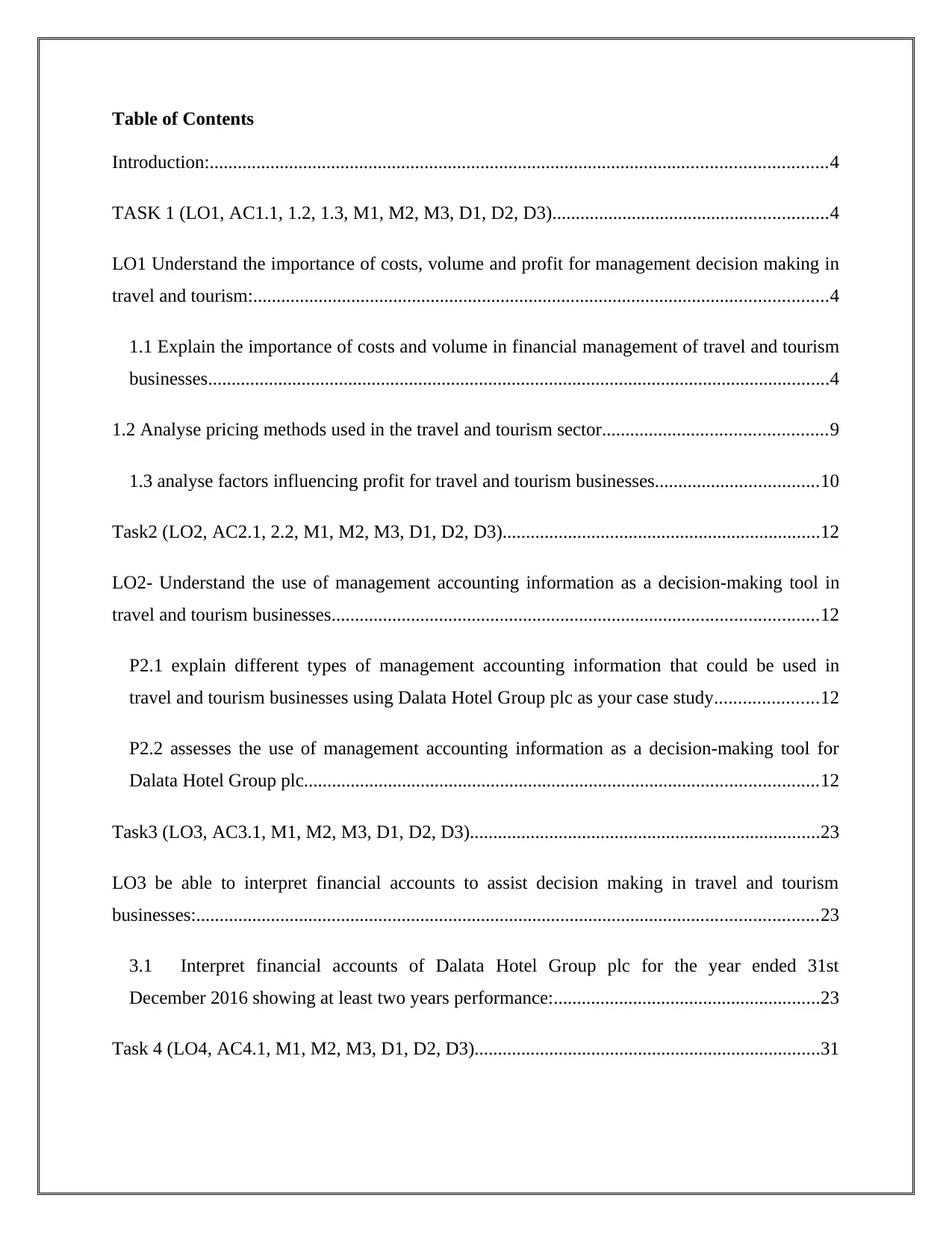
Table of Contents
Introduction:....................................................................................................................................4
TASK 1 (LO1, AC1.1, 1.2, 1.3, M1, M2, M3, D1, D2, D3)...........................................................4
LO1 Understand the importance of costs, volume and profit for management decision making in
travel and tourism:...........................................................................................................................4
1.1 Explain the importance of costs and volume in financial management of travel and tourism
businesses.....................................................................................................................................4
1.2 Analyse pricing methods used in the travel and tourism sector................................................9
1.3 analyse factors influencing profit for travel and tourism businesses...................................10
Task2 (LO2, AC2.1, 2.2, M1, M2, M3, D1, D2, D3)....................................................................12
LO2- Understand the use of management accounting information as a decision-making tool in
travel and tourism businesses........................................................................................................12
P2.1 explain different types of management accounting information that could be used in
travel and tourism businesses using Dalata Hotel Group plc as your case study......................12
P2.2 assesses the use of management accounting information as a decision-making tool for
Dalata Hotel Group plc..............................................................................................................12
Task3 (LO3, AC3.1, M1, M2, M3, D1, D2, D3)...........................................................................23
LO3 be able to interpret financial accounts to assist decision making in travel and tourism
businesses:.....................................................................................................................................23
3.1 Interpret financial accounts of Dalata Hotel Group plc for the year ended 31st
December 2016 showing at least two years performance:.........................................................23
Task 4 (LO4, AC4.1, M1, M2, M3, D1, D2, D3)..........................................................................31
Introduction:....................................................................................................................................4
TASK 1 (LO1, AC1.1, 1.2, 1.3, M1, M2, M3, D1, D2, D3)...........................................................4
LO1 Understand the importance of costs, volume and profit for management decision making in
travel and tourism:...........................................................................................................................4
1.1 Explain the importance of costs and volume in financial management of travel and tourism
businesses.....................................................................................................................................4
1.2 Analyse pricing methods used in the travel and tourism sector................................................9
1.3 analyse factors influencing profit for travel and tourism businesses...................................10
Task2 (LO2, AC2.1, 2.2, M1, M2, M3, D1, D2, D3)....................................................................12
LO2- Understand the use of management accounting information as a decision-making tool in
travel and tourism businesses........................................................................................................12
P2.1 explain different types of management accounting information that could be used in
travel and tourism businesses using Dalata Hotel Group plc as your case study......................12
P2.2 assesses the use of management accounting information as a decision-making tool for
Dalata Hotel Group plc..............................................................................................................12
Task3 (LO3, AC3.1, M1, M2, M3, D1, D2, D3)...........................................................................23
LO3 be able to interpret financial accounts to assist decision making in travel and tourism
businesses:.....................................................................................................................................23
3.1 Interpret financial accounts of Dalata Hotel Group plc for the year ended 31st
December 2016 showing at least two years performance:.........................................................23
Task 4 (LO4, AC4.1, M1, M2, M3, D1, D2, D3)..........................................................................31
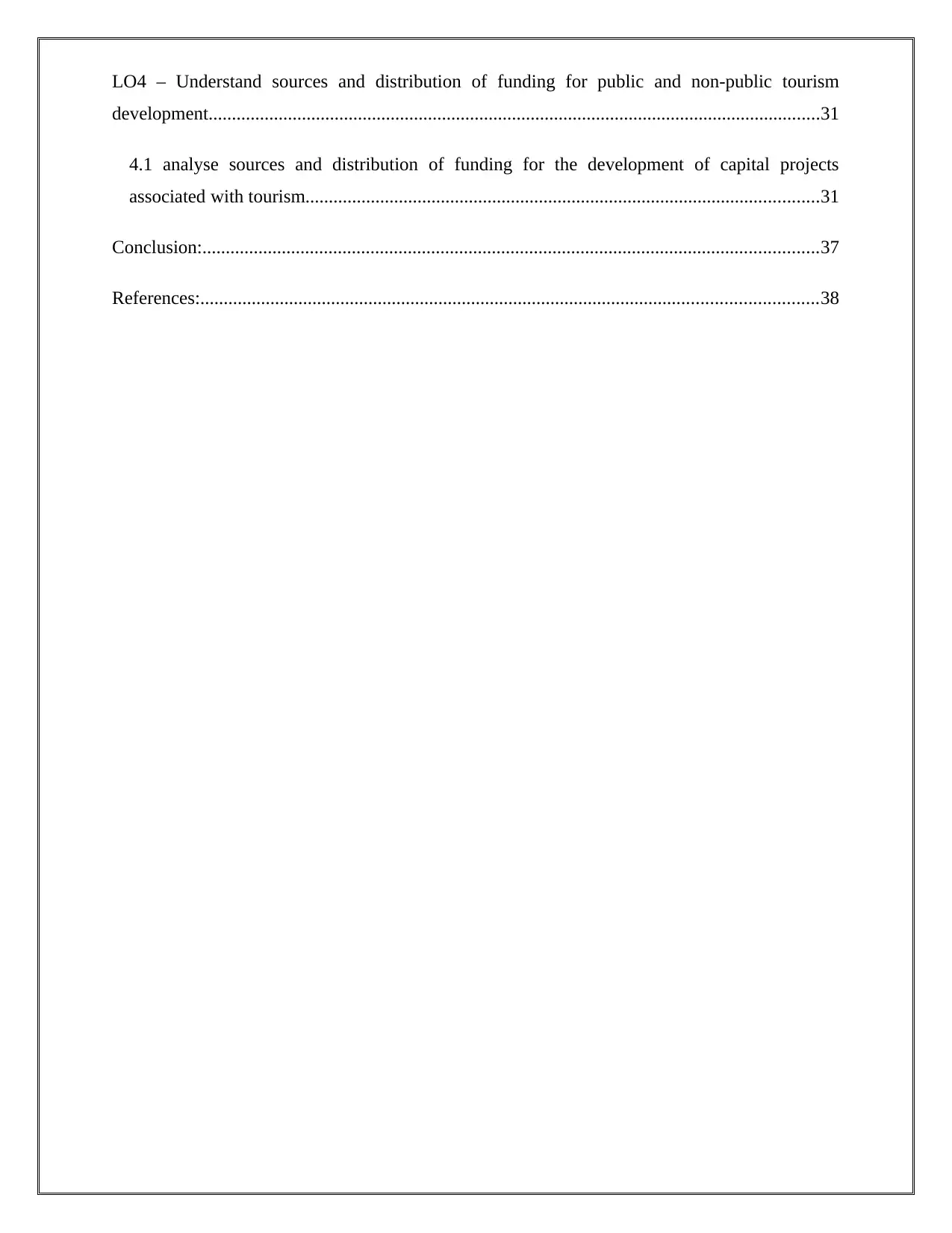
LO4 – Understand sources and distribution of funding for public and non-public tourism
development...................................................................................................................................31
4.1 analyse sources and distribution of funding for the development of capital projects
associated with tourism..............................................................................................................31
Conclusion:....................................................................................................................................37
References:....................................................................................................................................38
development...................................................................................................................................31
4.1 analyse sources and distribution of funding for the development of capital projects
associated with tourism..............................................................................................................31
Conclusion:....................................................................................................................................37
References:....................................................................................................................................38
⊘ This is a preview!⊘
Do you want full access?
Subscribe today to unlock all pages.

Trusted by 1+ million students worldwide
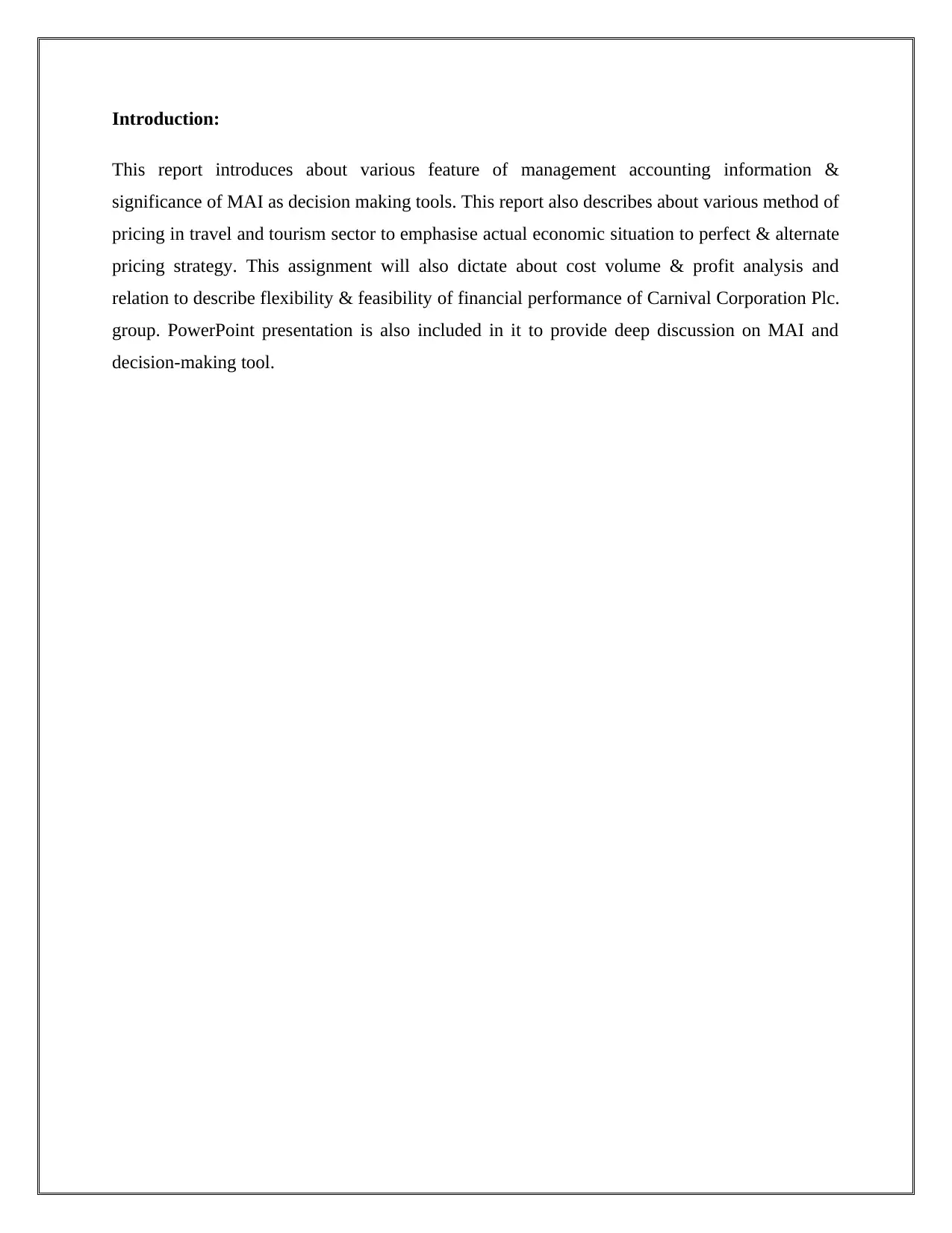
Introduction:
This report introduces about various feature of management accounting information &
significance of MAI as decision making tools. This report also describes about various method of
pricing in travel and tourism sector to emphasise actual economic situation to perfect & alternate
pricing strategy. This assignment will also dictate about cost volume & profit analysis and
relation to describe flexibility & feasibility of financial performance of Carnival Corporation Plc.
group. PowerPoint presentation is also included in it to provide deep discussion on MAI and
decision-making tool.
This report introduces about various feature of management accounting information &
significance of MAI as decision making tools. This report also describes about various method of
pricing in travel and tourism sector to emphasise actual economic situation to perfect & alternate
pricing strategy. This assignment will also dictate about cost volume & profit analysis and
relation to describe flexibility & feasibility of financial performance of Carnival Corporation Plc.
group. PowerPoint presentation is also included in it to provide deep discussion on MAI and
decision-making tool.
Paraphrase This Document
Need a fresh take? Get an instant paraphrase of this document with our AI Paraphraser
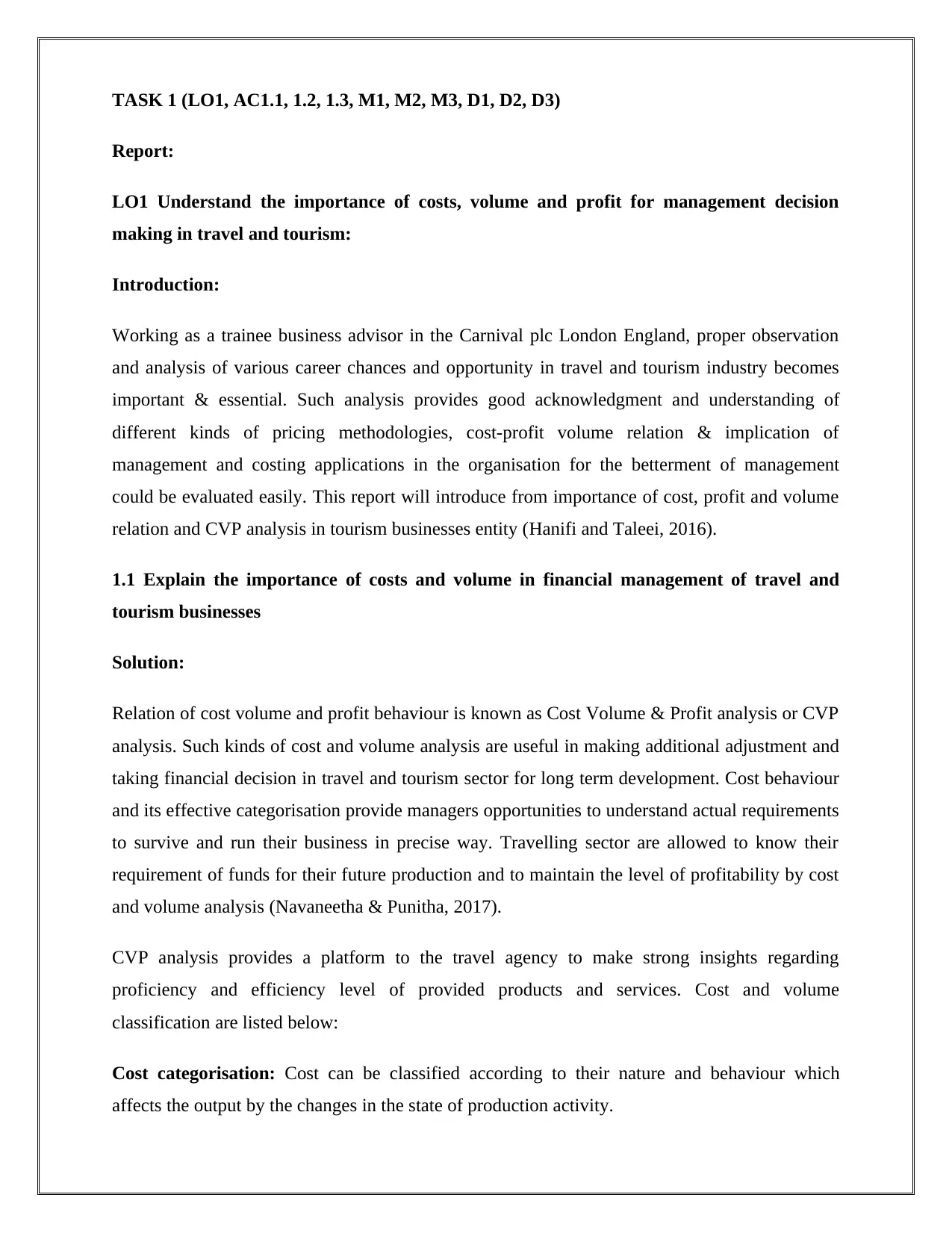
TASK 1 (LO1, AC1.1, 1.2, 1.3, M1, M2, M3, D1, D2, D3)
Report:
LO1 Understand the importance of costs, volume and profit for management decision
making in travel and tourism:
Introduction:
Working as a trainee business advisor in the Carnival plc London England, proper observation
and analysis of various career chances and opportunity in travel and tourism industry becomes
important & essential. Such analysis provides good acknowledgment and understanding of
different kinds of pricing methodologies, cost-profit volume relation & implication of
management and costing applications in the organisation for the betterment of management
could be evaluated easily. This report will introduce from importance of cost, profit and volume
relation and CVP analysis in tourism businesses entity (Hanifi and Taleei, 2016).
1.1 Explain the importance of costs and volume in financial management of travel and
tourism businesses
Solution:
Relation of cost volume and profit behaviour is known as Cost Volume & Profit analysis or CVP
analysis. Such kinds of cost and volume analysis are useful in making additional adjustment and
taking financial decision in travel and tourism sector for long term development. Cost behaviour
and its effective categorisation provide managers opportunities to understand actual requirements
to survive and run their business in precise way. Travelling sector are allowed to know their
requirement of funds for their future production and to maintain the level of profitability by cost
and volume analysis (Navaneetha & Punitha, 2017).
CVP analysis provides a platform to the travel agency to make strong insights regarding
proficiency and efficiency level of provided products and services. Cost and volume
classification are listed below:
Cost categorisation: Cost can be classified according to their nature and behaviour which
affects the output by the changes in the state of production activity.
Report:
LO1 Understand the importance of costs, volume and profit for management decision
making in travel and tourism:
Introduction:
Working as a trainee business advisor in the Carnival plc London England, proper observation
and analysis of various career chances and opportunity in travel and tourism industry becomes
important & essential. Such analysis provides good acknowledgment and understanding of
different kinds of pricing methodologies, cost-profit volume relation & implication of
management and costing applications in the organisation for the betterment of management
could be evaluated easily. This report will introduce from importance of cost, profit and volume
relation and CVP analysis in tourism businesses entity (Hanifi and Taleei, 2016).
1.1 Explain the importance of costs and volume in financial management of travel and
tourism businesses
Solution:
Relation of cost volume and profit behaviour is known as Cost Volume & Profit analysis or CVP
analysis. Such kinds of cost and volume analysis are useful in making additional adjustment and
taking financial decision in travel and tourism sector for long term development. Cost behaviour
and its effective categorisation provide managers opportunities to understand actual requirements
to survive and run their business in precise way. Travelling sector are allowed to know their
requirement of funds for their future production and to maintain the level of profitability by cost
and volume analysis (Navaneetha & Punitha, 2017).
CVP analysis provides a platform to the travel agency to make strong insights regarding
proficiency and efficiency level of provided products and services. Cost and volume
classification are listed below:
Cost categorisation: Cost can be classified according to their nature and behaviour which
affects the output by the changes in the state of production activity.
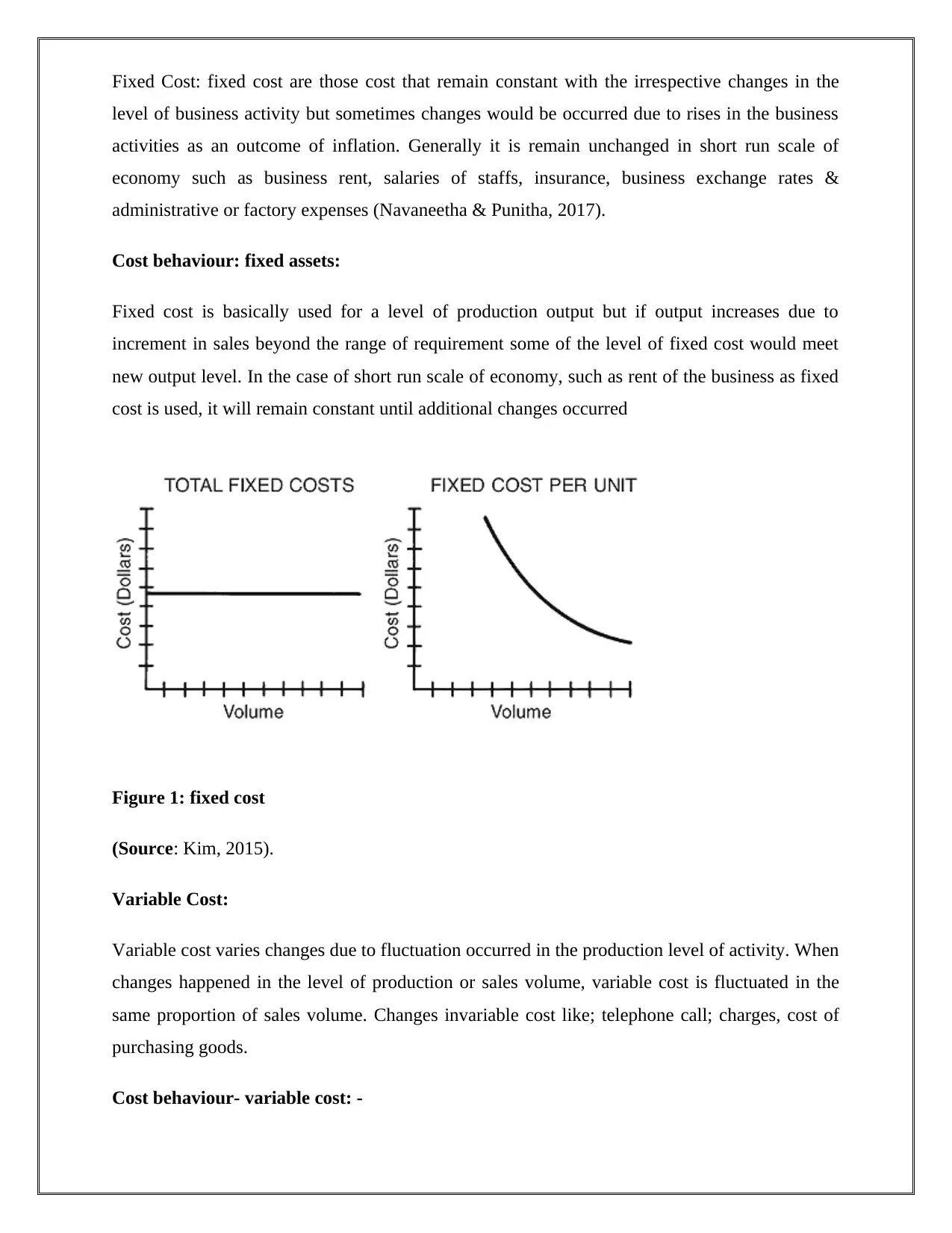
Fixed Cost: fixed cost are those cost that remain constant with the irrespective changes in the
level of business activity but sometimes changes would be occurred due to rises in the business
activities as an outcome of inflation. Generally it is remain unchanged in short run scale of
economy such as business rent, salaries of staffs, insurance, business exchange rates &
administrative or factory expenses (Navaneetha & Punitha, 2017).
Cost behaviour: fixed assets:
Fixed cost is basically used for a level of production output but if output increases due to
increment in sales beyond the range of requirement some of the level of fixed cost would meet
new output level. In the case of short run scale of economy, such as rent of the business as fixed
cost is used, it will remain constant until additional changes occurred
Figure 1: fixed cost
(Source: Kim, 2015).
Variable Cost:
Variable cost varies changes due to fluctuation occurred in the production level of activity. When
changes happened in the level of production or sales volume, variable cost is fluctuated in the
same proportion of sales volume. Changes invariable cost like; telephone call; charges, cost of
purchasing goods.
Cost behaviour- variable cost: -
level of business activity but sometimes changes would be occurred due to rises in the business
activities as an outcome of inflation. Generally it is remain unchanged in short run scale of
economy such as business rent, salaries of staffs, insurance, business exchange rates &
administrative or factory expenses (Navaneetha & Punitha, 2017).
Cost behaviour: fixed assets:
Fixed cost is basically used for a level of production output but if output increases due to
increment in sales beyond the range of requirement some of the level of fixed cost would meet
new output level. In the case of short run scale of economy, such as rent of the business as fixed
cost is used, it will remain constant until additional changes occurred
Figure 1: fixed cost
(Source: Kim, 2015).
Variable Cost:
Variable cost varies changes due to fluctuation occurred in the production level of activity. When
changes happened in the level of production or sales volume, variable cost is fluctuated in the
same proportion of sales volume. Changes invariable cost like; telephone call; charges, cost of
purchasing goods.
Cost behaviour- variable cost: -
⊘ This is a preview!⊘
Do you want full access?
Subscribe today to unlock all pages.

Trusted by 1+ million students worldwide
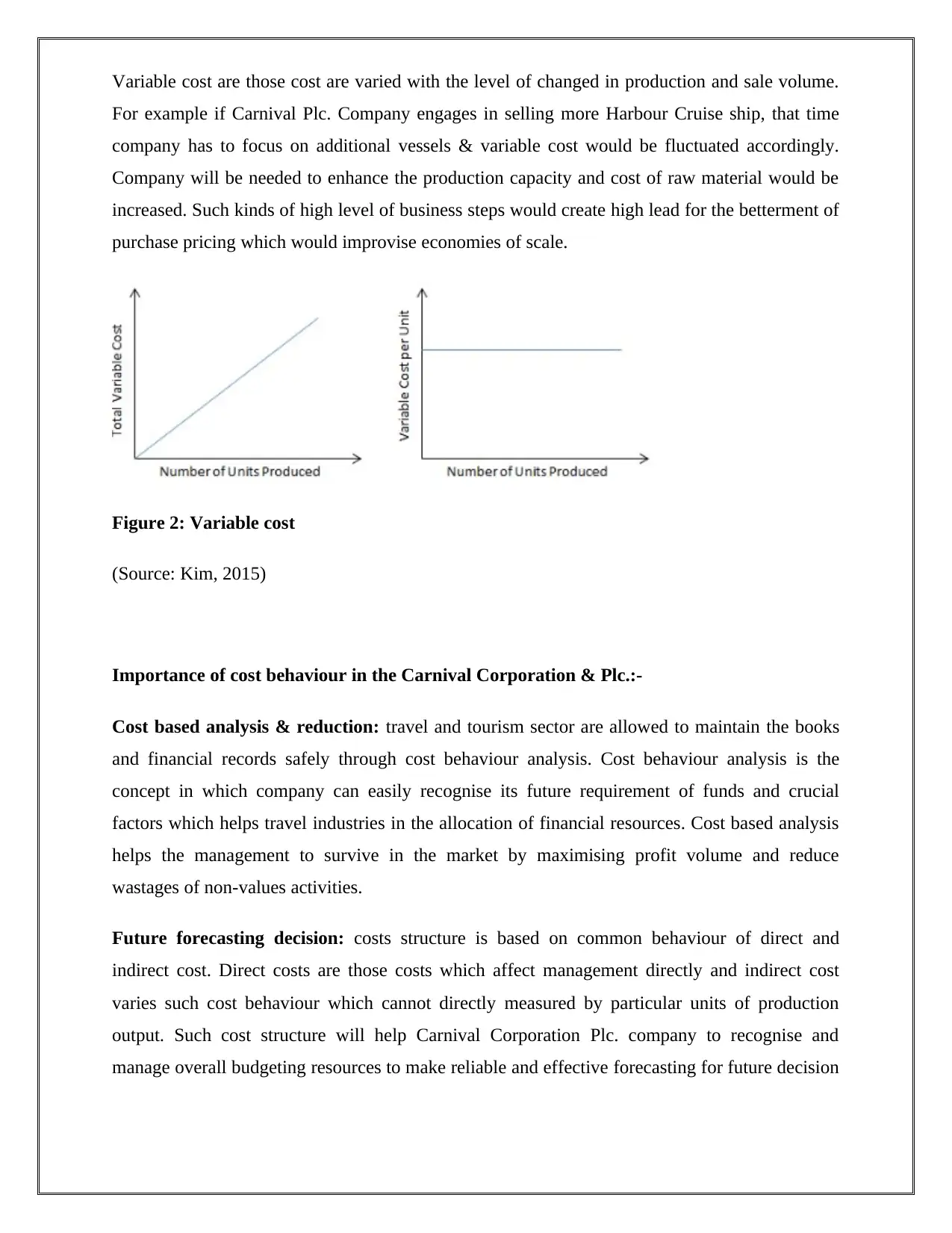
Variable cost are those cost are varied with the level of changed in production and sale volume.
For example if Carnival Plc. Company engages in selling more Harbour Cruise ship, that time
company has to focus on additional vessels & variable cost would be fluctuated accordingly.
Company will be needed to enhance the production capacity and cost of raw material would be
increased. Such kinds of high level of business steps would create high lead for the betterment of
purchase pricing which would improvise economies of scale.
Figure 2: Variable cost
(Source: Kim, 2015)
Importance of cost behaviour in the Carnival Corporation & Plc.:-
Cost based analysis & reduction: travel and tourism sector are allowed to maintain the books
and financial records safely through cost behaviour analysis. Cost behaviour analysis is the
concept in which company can easily recognise its future requirement of funds and crucial
factors which helps travel industries in the allocation of financial resources. Cost based analysis
helps the management to survive in the market by maximising profit volume and reduce
wastages of non-values activities.
Future forecasting decision: costs structure is based on common behaviour of direct and
indirect cost. Direct costs are those costs which affect management directly and indirect cost
varies such cost behaviour which cannot directly measured by particular units of production
output. Such cost structure will help Carnival Corporation Plc. company to recognise and
manage overall budgeting resources to make reliable and effective forecasting for future decision
For example if Carnival Plc. Company engages in selling more Harbour Cruise ship, that time
company has to focus on additional vessels & variable cost would be fluctuated accordingly.
Company will be needed to enhance the production capacity and cost of raw material would be
increased. Such kinds of high level of business steps would create high lead for the betterment of
purchase pricing which would improvise economies of scale.
Figure 2: Variable cost
(Source: Kim, 2015)
Importance of cost behaviour in the Carnival Corporation & Plc.:-
Cost based analysis & reduction: travel and tourism sector are allowed to maintain the books
and financial records safely through cost behaviour analysis. Cost behaviour analysis is the
concept in which company can easily recognise its future requirement of funds and crucial
factors which helps travel industries in the allocation of financial resources. Cost based analysis
helps the management to survive in the market by maximising profit volume and reduce
wastages of non-values activities.
Future forecasting decision: costs structure is based on common behaviour of direct and
indirect cost. Direct costs are those costs which affect management directly and indirect cost
varies such cost behaviour which cannot directly measured by particular units of production
output. Such cost structure will help Carnival Corporation Plc. company to recognise and
manage overall budgeting resources to make reliable and effective forecasting for future decision
Paraphrase This Document
Need a fresh take? Get an instant paraphrase of this document with our AI Paraphraser
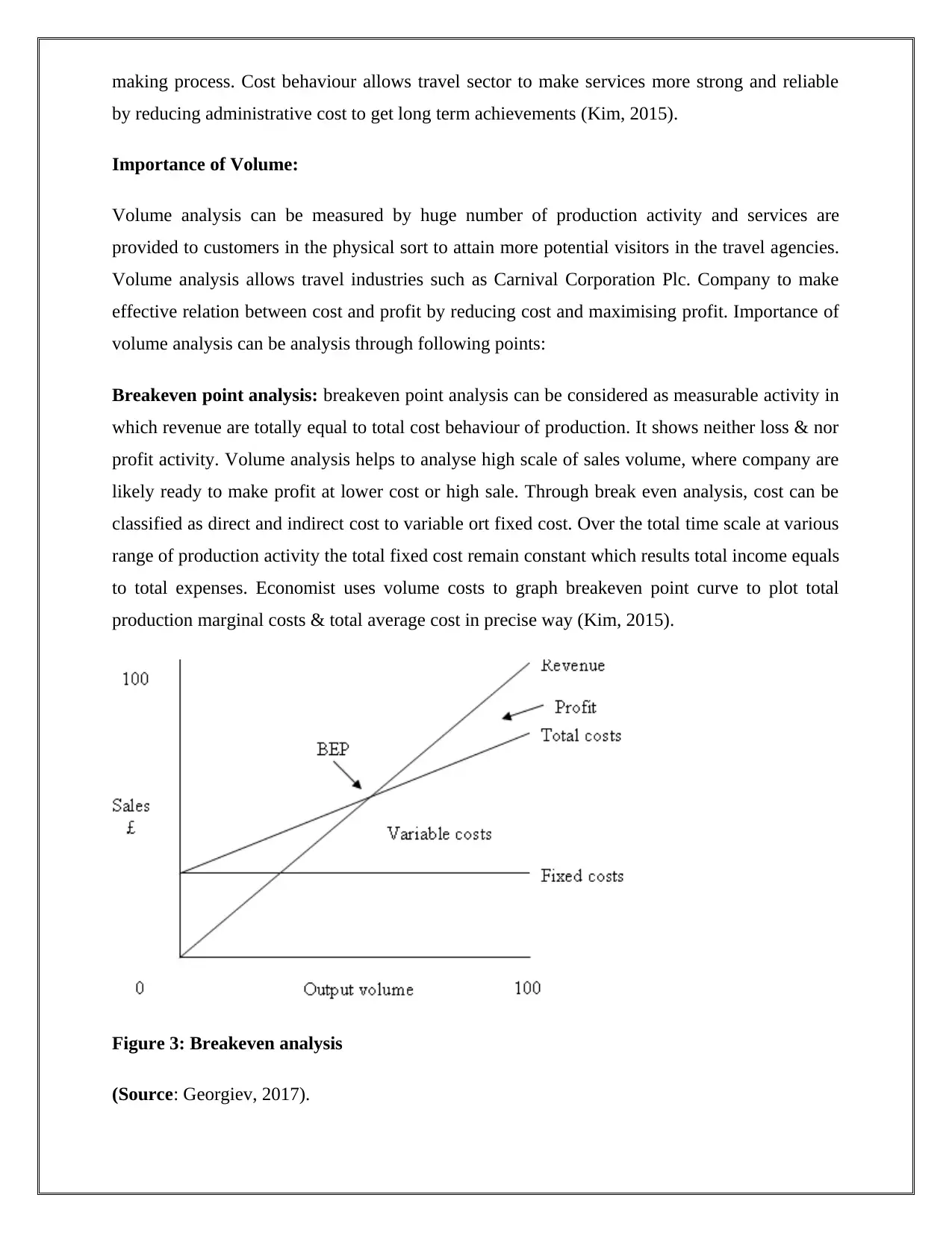
making process. Cost behaviour allows travel sector to make services more strong and reliable
by reducing administrative cost to get long term achievements (Kim, 2015).
Importance of Volume:
Volume analysis can be measured by huge number of production activity and services are
provided to customers in the physical sort to attain more potential visitors in the travel agencies.
Volume analysis allows travel industries such as Carnival Corporation Plc. Company to make
effective relation between cost and profit by reducing cost and maximising profit. Importance of
volume analysis can be analysis through following points:
Breakeven point analysis: breakeven point analysis can be considered as measurable activity in
which revenue are totally equal to total cost behaviour of production. It shows neither loss & nor
profit activity. Volume analysis helps to analyse high scale of sales volume, where company are
likely ready to make profit at lower cost or high sale. Through break even analysis, cost can be
classified as direct and indirect cost to variable ort fixed cost. Over the total time scale at various
range of production activity the total fixed cost remain constant which results total income equals
to total expenses. Economist uses volume costs to graph breakeven point curve to plot total
production marginal costs & total average cost in precise way (Kim, 2015).
Figure 3: Breakeven analysis
(Source: Georgiev, 2017).
by reducing administrative cost to get long term achievements (Kim, 2015).
Importance of Volume:
Volume analysis can be measured by huge number of production activity and services are
provided to customers in the physical sort to attain more potential visitors in the travel agencies.
Volume analysis allows travel industries such as Carnival Corporation Plc. Company to make
effective relation between cost and profit by reducing cost and maximising profit. Importance of
volume analysis can be analysis through following points:
Breakeven point analysis: breakeven point analysis can be considered as measurable activity in
which revenue are totally equal to total cost behaviour of production. It shows neither loss & nor
profit activity. Volume analysis helps to analyse high scale of sales volume, where company are
likely ready to make profit at lower cost or high sale. Through break even analysis, cost can be
classified as direct and indirect cost to variable ort fixed cost. Over the total time scale at various
range of production activity the total fixed cost remain constant which results total income equals
to total expenses. Economist uses volume costs to graph breakeven point curve to plot total
production marginal costs & total average cost in precise way (Kim, 2015).
Figure 3: Breakeven analysis
(Source: Georgiev, 2017).
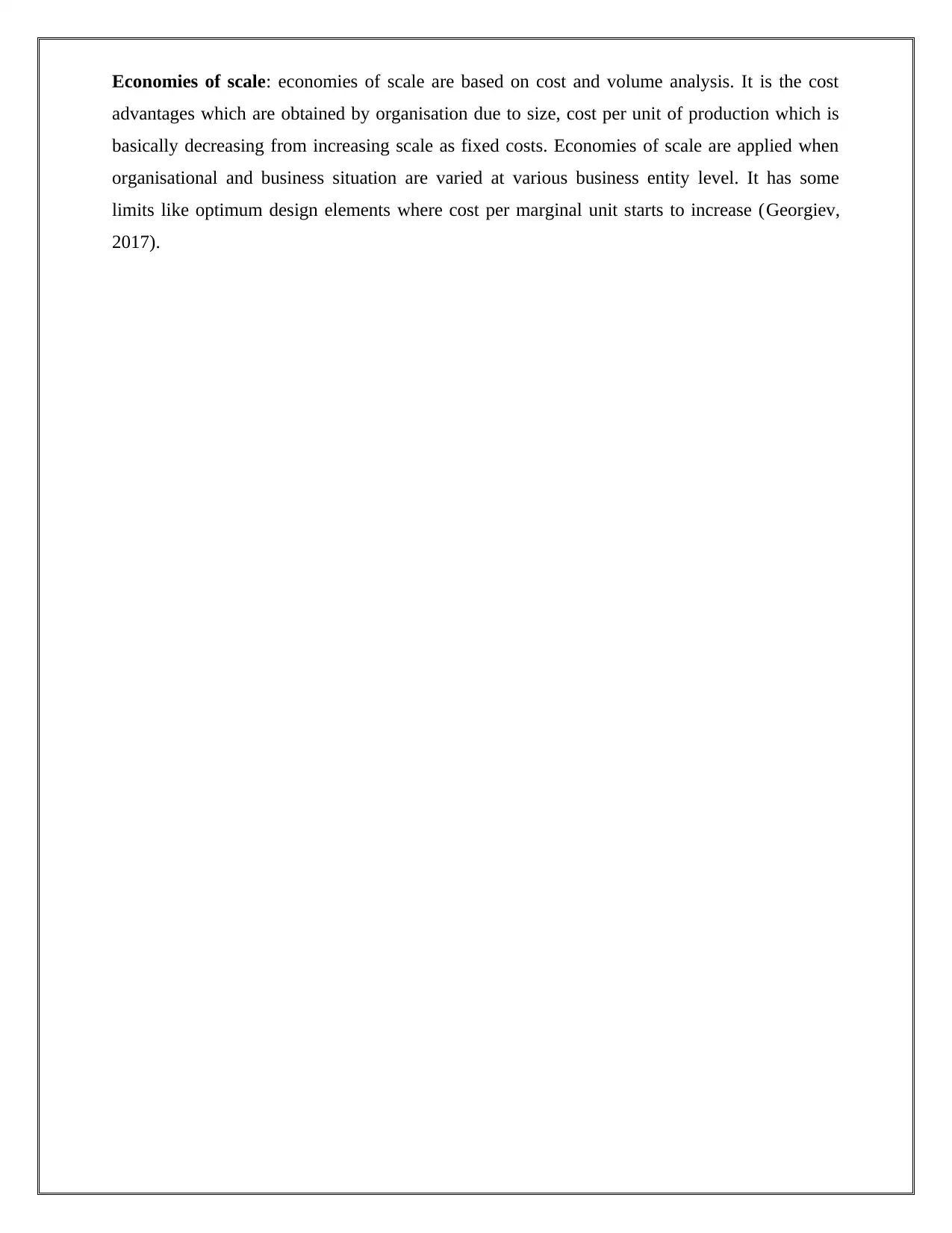
Economies of scale: economies of scale are based on cost and volume analysis. It is the cost
advantages which are obtained by organisation due to size, cost per unit of production which is
basically decreasing from increasing scale as fixed costs. Economies of scale are applied when
organisational and business situation are varied at various business entity level. It has some
limits like optimum design elements where cost per marginal unit starts to increase (Georgiev,
2017).
advantages which are obtained by organisation due to size, cost per unit of production which is
basically decreasing from increasing scale as fixed costs. Economies of scale are applied when
organisational and business situation are varied at various business entity level. It has some
limits like optimum design elements where cost per marginal unit starts to increase (Georgiev,
2017).
⊘ This is a preview!⊘
Do you want full access?
Subscribe today to unlock all pages.

Trusted by 1+ million students worldwide
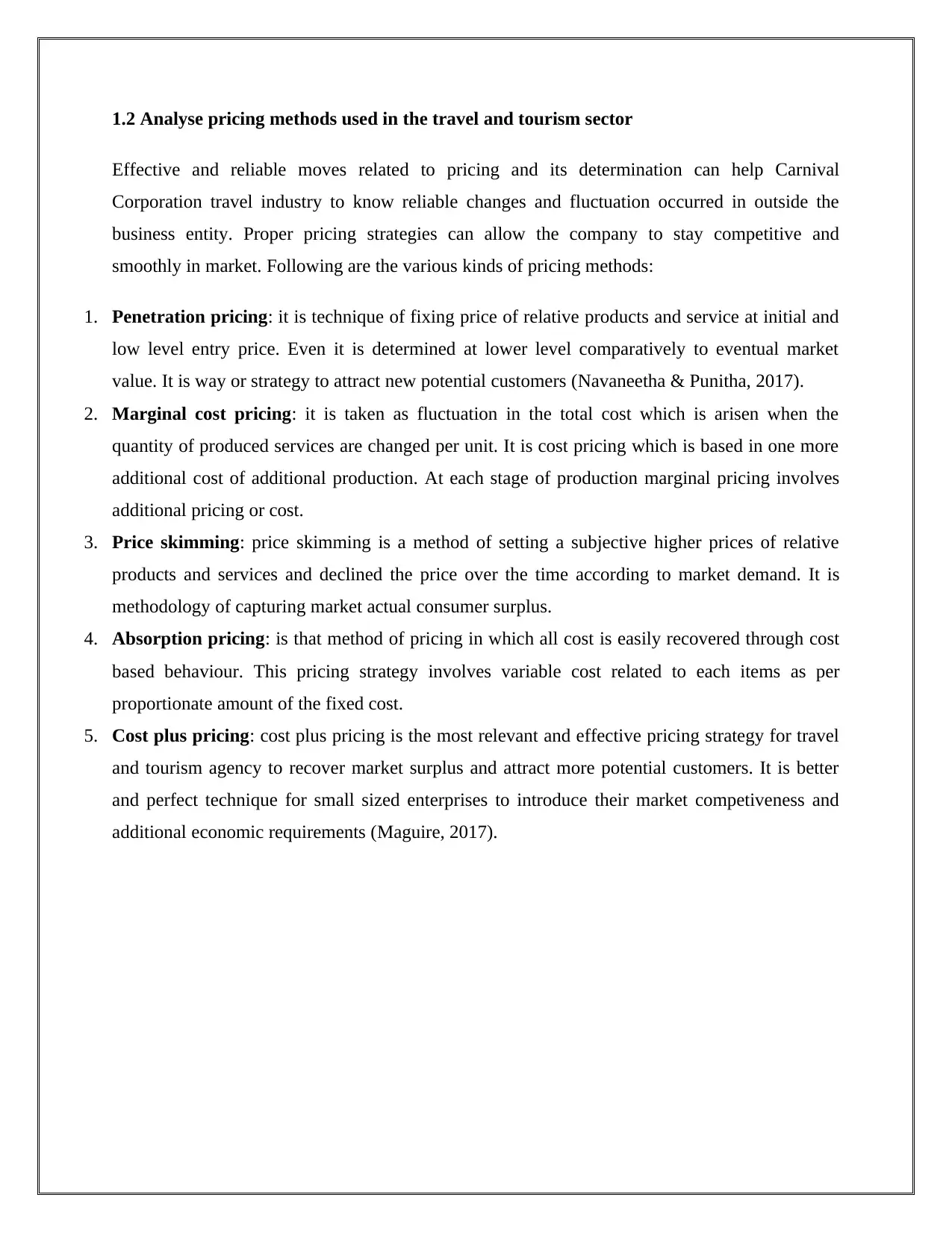
1.2 Analyse pricing methods used in the travel and tourism sector
Effective and reliable moves related to pricing and its determination can help Carnival
Corporation travel industry to know reliable changes and fluctuation occurred in outside the
business entity. Proper pricing strategies can allow the company to stay competitive and
smoothly in market. Following are the various kinds of pricing methods:
1. Penetration pricing: it is technique of fixing price of relative products and service at initial and
low level entry price. Even it is determined at lower level comparatively to eventual market
value. It is way or strategy to attract new potential customers (Navaneetha & Punitha, 2017).
2. Marginal cost pricing: it is taken as fluctuation in the total cost which is arisen when the
quantity of produced services are changed per unit. It is cost pricing which is based in one more
additional cost of additional production. At each stage of production marginal pricing involves
additional pricing or cost.
3. Price skimming: price skimming is a method of setting a subjective higher prices of relative
products and services and declined the price over the time according to market demand. It is
methodology of capturing market actual consumer surplus.
4. Absorption pricing: is that method of pricing in which all cost is easily recovered through cost
based behaviour. This pricing strategy involves variable cost related to each items as per
proportionate amount of the fixed cost.
5. Cost plus pricing: cost plus pricing is the most relevant and effective pricing strategy for travel
and tourism agency to recover market surplus and attract more potential customers. It is better
and perfect technique for small sized enterprises to introduce their market competiveness and
additional economic requirements (Maguire, 2017).
Effective and reliable moves related to pricing and its determination can help Carnival
Corporation travel industry to know reliable changes and fluctuation occurred in outside the
business entity. Proper pricing strategies can allow the company to stay competitive and
smoothly in market. Following are the various kinds of pricing methods:
1. Penetration pricing: it is technique of fixing price of relative products and service at initial and
low level entry price. Even it is determined at lower level comparatively to eventual market
value. It is way or strategy to attract new potential customers (Navaneetha & Punitha, 2017).
2. Marginal cost pricing: it is taken as fluctuation in the total cost which is arisen when the
quantity of produced services are changed per unit. It is cost pricing which is based in one more
additional cost of additional production. At each stage of production marginal pricing involves
additional pricing or cost.
3. Price skimming: price skimming is a method of setting a subjective higher prices of relative
products and services and declined the price over the time according to market demand. It is
methodology of capturing market actual consumer surplus.
4. Absorption pricing: is that method of pricing in which all cost is easily recovered through cost
based behaviour. This pricing strategy involves variable cost related to each items as per
proportionate amount of the fixed cost.
5. Cost plus pricing: cost plus pricing is the most relevant and effective pricing strategy for travel
and tourism agency to recover market surplus and attract more potential customers. It is better
and perfect technique for small sized enterprises to introduce their market competiveness and
additional economic requirements (Maguire, 2017).
Paraphrase This Document
Need a fresh take? Get an instant paraphrase of this document with our AI Paraphraser
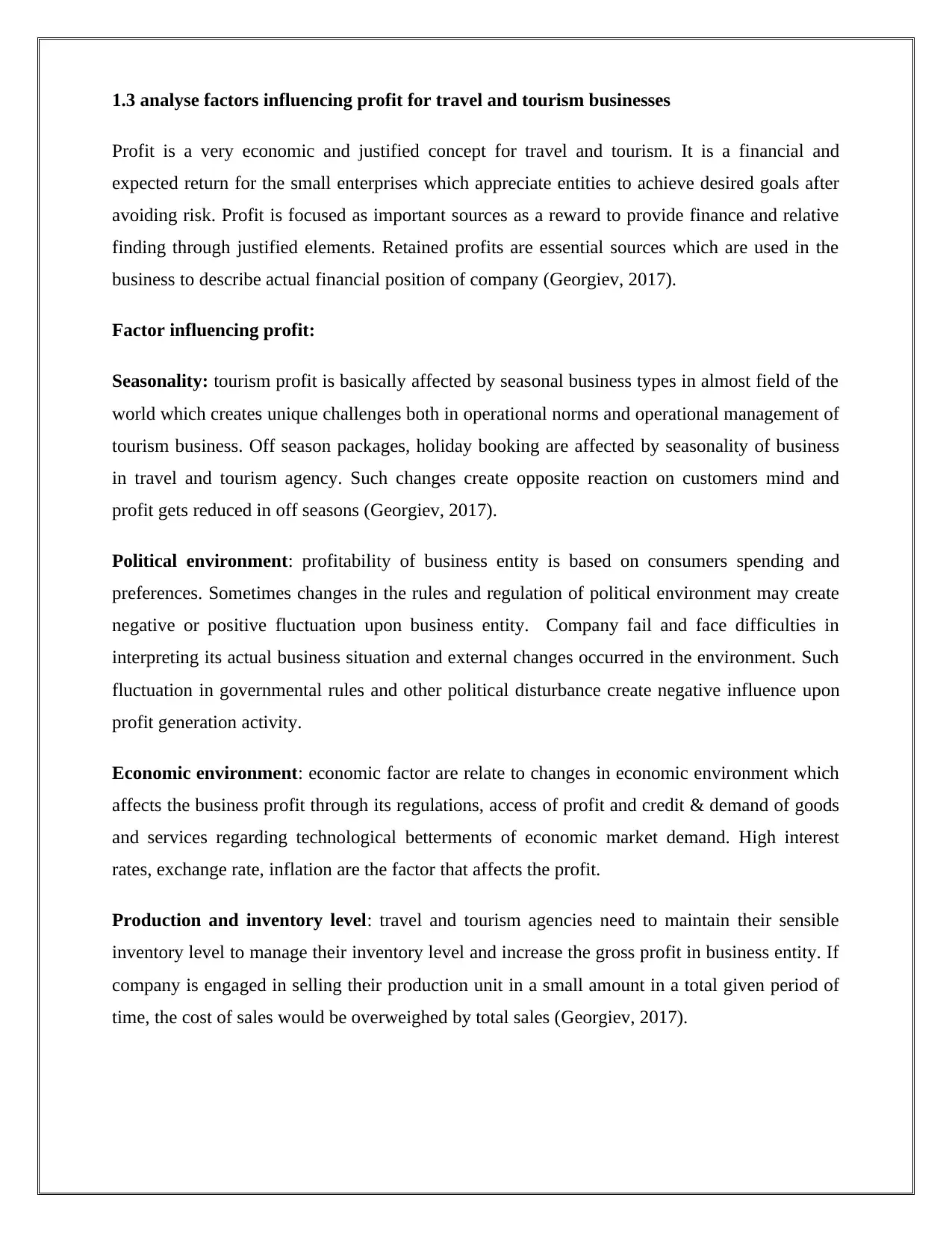
1.3 analyse factors influencing profit for travel and tourism businesses
Profit is a very economic and justified concept for travel and tourism. It is a financial and
expected return for the small enterprises which appreciate entities to achieve desired goals after
avoiding risk. Profit is focused as important sources as a reward to provide finance and relative
finding through justified elements. Retained profits are essential sources which are used in the
business to describe actual financial position of company (Georgiev, 2017).
Factor influencing profit:
Seasonality: tourism profit is basically affected by seasonal business types in almost field of the
world which creates unique challenges both in operational norms and operational management of
tourism business. Off season packages, holiday booking are affected by seasonality of business
in travel and tourism agency. Such changes create opposite reaction on customers mind and
profit gets reduced in off seasons (Georgiev, 2017).
Political environment: profitability of business entity is based on consumers spending and
preferences. Sometimes changes in the rules and regulation of political environment may create
negative or positive fluctuation upon business entity. Company fail and face difficulties in
interpreting its actual business situation and external changes occurred in the environment. Such
fluctuation in governmental rules and other political disturbance create negative influence upon
profit generation activity.
Economic environment: economic factor are relate to changes in economic environment which
affects the business profit through its regulations, access of profit and credit & demand of goods
and services regarding technological betterments of economic market demand. High interest
rates, exchange rate, inflation are the factor that affects the profit.
Production and inventory level: travel and tourism agencies need to maintain their sensible
inventory level to manage their inventory level and increase the gross profit in business entity. If
company is engaged in selling their production unit in a small amount in a total given period of
time, the cost of sales would be overweighed by total sales (Georgiev, 2017).
Profit is a very economic and justified concept for travel and tourism. It is a financial and
expected return for the small enterprises which appreciate entities to achieve desired goals after
avoiding risk. Profit is focused as important sources as a reward to provide finance and relative
finding through justified elements. Retained profits are essential sources which are used in the
business to describe actual financial position of company (Georgiev, 2017).
Factor influencing profit:
Seasonality: tourism profit is basically affected by seasonal business types in almost field of the
world which creates unique challenges both in operational norms and operational management of
tourism business. Off season packages, holiday booking are affected by seasonality of business
in travel and tourism agency. Such changes create opposite reaction on customers mind and
profit gets reduced in off seasons (Georgiev, 2017).
Political environment: profitability of business entity is based on consumers spending and
preferences. Sometimes changes in the rules and regulation of political environment may create
negative or positive fluctuation upon business entity. Company fail and face difficulties in
interpreting its actual business situation and external changes occurred in the environment. Such
fluctuation in governmental rules and other political disturbance create negative influence upon
profit generation activity.
Economic environment: economic factor are relate to changes in economic environment which
affects the business profit through its regulations, access of profit and credit & demand of goods
and services regarding technological betterments of economic market demand. High interest
rates, exchange rate, inflation are the factor that affects the profit.
Production and inventory level: travel and tourism agencies need to maintain their sensible
inventory level to manage their inventory level and increase the gross profit in business entity. If
company is engaged in selling their production unit in a small amount in a total given period of
time, the cost of sales would be overweighed by total sales (Georgiev, 2017).
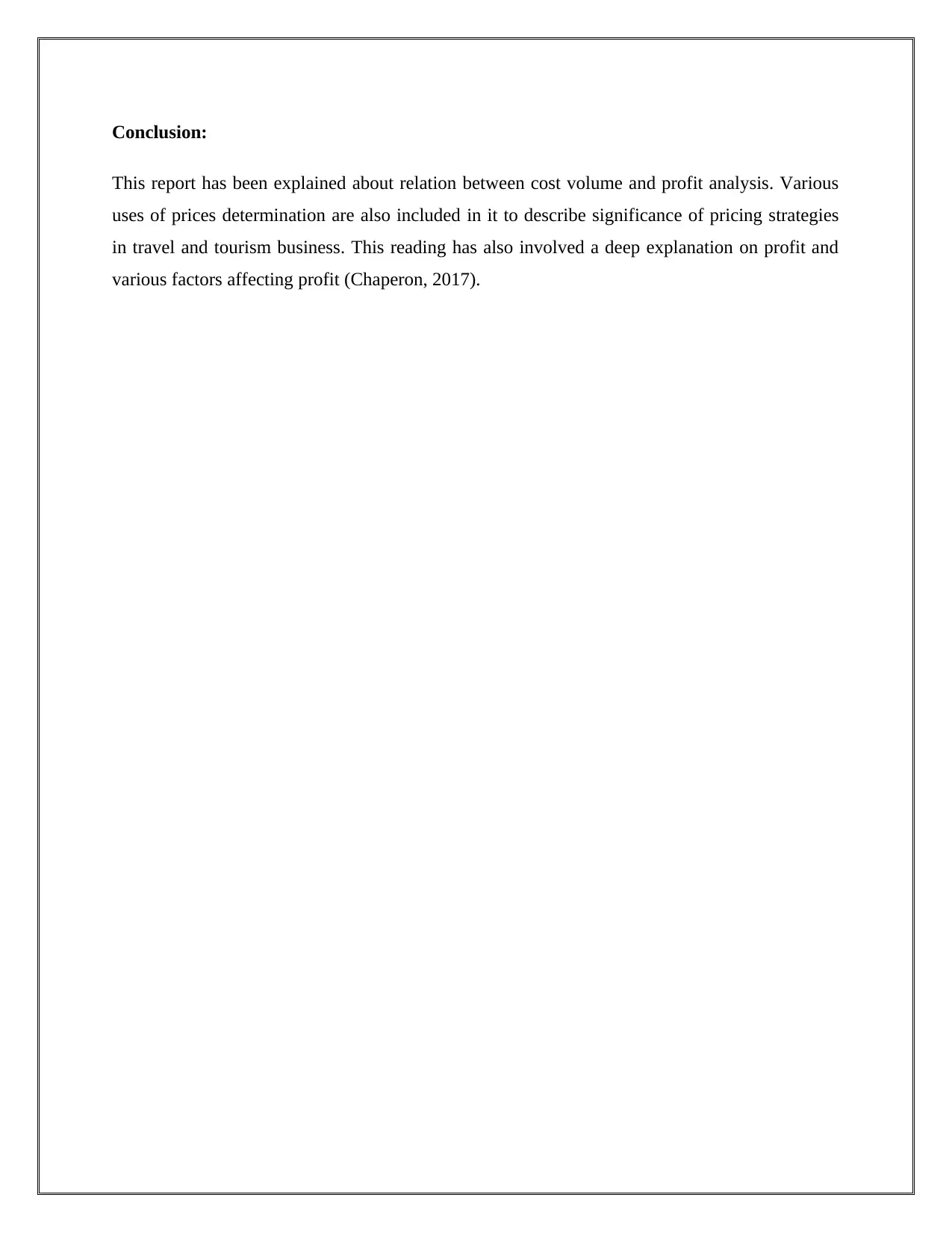
Conclusion:
This report has been explained about relation between cost volume and profit analysis. Various
uses of prices determination are also included in it to describe significance of pricing strategies
in travel and tourism business. This reading has also involved a deep explanation on profit and
various factors affecting profit (Chaperon, 2017).
This report has been explained about relation between cost volume and profit analysis. Various
uses of prices determination are also included in it to describe significance of pricing strategies
in travel and tourism business. This reading has also involved a deep explanation on profit and
various factors affecting profit (Chaperon, 2017).
⊘ This is a preview!⊘
Do you want full access?
Subscribe today to unlock all pages.

Trusted by 1+ million students worldwide
1 out of 40
Related Documents
Your All-in-One AI-Powered Toolkit for Academic Success.
+13062052269
info@desklib.com
Available 24*7 on WhatsApp / Email
![[object Object]](/_next/static/media/star-bottom.7253800d.svg)
Unlock your academic potential
Copyright © 2020–2025 A2Z Services. All Rights Reserved. Developed and managed by ZUCOL.





